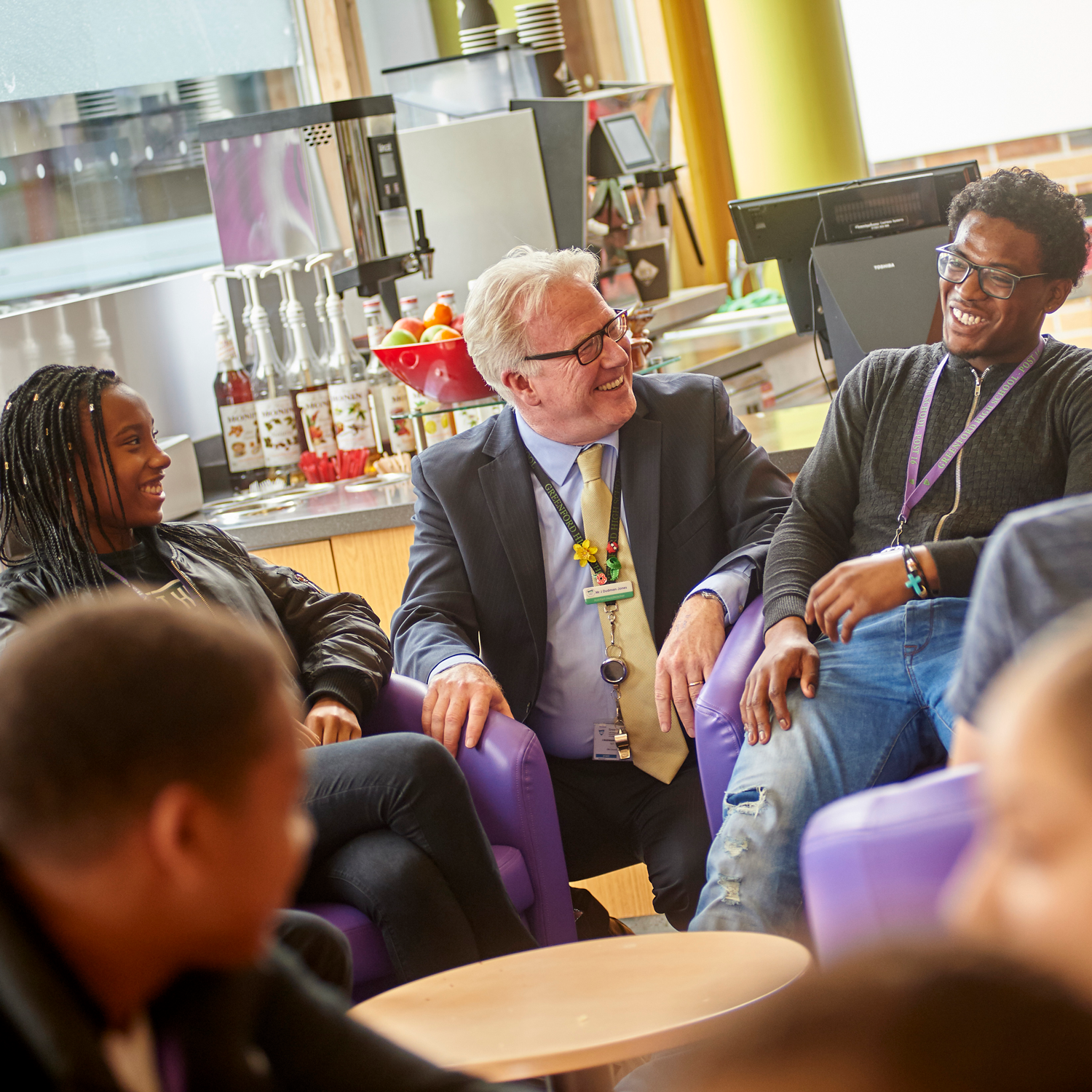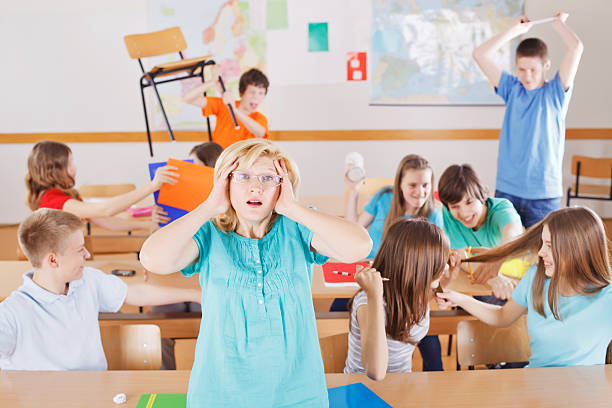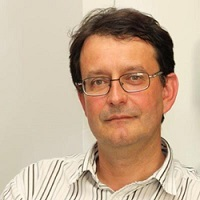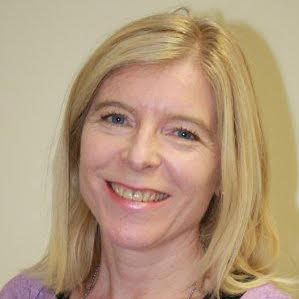
In this blog, we look at an example of how scientific insights from educational neuroscience can practically inform classroom practice. We talk to UK high-school teacher Jeremy Dudman-Jones who has found educational neuroscience research integral to his professional approach – to the extent that he gives talks on the topic to students, teachers, parents, and even business professionals. Jeremy (centre above) is an experienced high-school teacher and assistant head in a London school. He has taught for over 34 years, including in three culturally diverse public schools in London, teaching geography, psychology, government and politics, and sociology.
We asked Jeremy three questions: How did he first encounter educational neuroscience? Which findings from neuroscience did he feel were most important in his practice? And how did he communicate educational neuroscience to others (and what was their response)?
We first asked Jeremy how he had encountered educational neuroscience: As a young adult training to be a teacher, it was obvious to me that engaging with a young person’s brain was going to be an important part of my job and as someone who had studied a biology degree, I had some vague understanding of the importance of chemical neurotransmitters and neurons even back in the early 1980s. The penny dropped in the mid-1990s with the publication of Steven Pinker’s “The Language instinct” and Judith Harris’ “The nurture assumption”. These books gave me the first insights into the fact that the brain was plastic, that it changed and that at certain periods of one’s life, it seemed to almost have greater specific skills.
The pre and post adolescent brains that I had been interacting with as a professional were different, were changing and were miraculous. In the early 2000s, when I was a tutor at the University of London Institute of Education working with teachers training in social science, I began to tell them about brain plasticity, a term that was being increasingly referenced in the literature I was reading. One of the new teachers seemed not to be particularly engaged so I asked what the problem was, and they said, “I don’t need to know what goes on under the bonnet, all I need you to tell me is how to drive the car”. For me, this became my inspiration and from then on, I resolved to learn more about neuroscience and to translate it, as any good teacher should be able to do, into meaningful and useful information for my teaching colleagues and I have continued this approach for over 20 years.
We next asked Jeremy which findings from neuroscience were most important in his practice: Having read the literature over the past few decades, it seemed to me that as a teacher I should try to focus on four main areas:
- The idea of brain plasticity, of laying down neural connections and of synaptic pruning.
- The idea that the brain in a sense matures as people go through adolescence and into adulthood – which parts of the brain appear to mature later and the impact this might have on behaviour and attitudes to learning.
- Circadian rhythms are also important, given the timing of the school day, the importance of sleep and the apparent lag time the adolescent brain as in producing melatonin compared to the adult brain.
- The role of neurotransmitters especially dopamine (for reward), serotonin (for mood) and oxytocin (for social bonding).
All of these insights have been useful to me as a teacher, pastoral lead and member of the school’s leadership team; I have certainly become more understanding and therefore more sympathetic to the changing attitudes of the secondary school student; I have been able to think more clearly about the need to return to topics to slow down or prevent synaptic pruning, I have been able to incorporate more dopamine events into the curriculum and use the “high five” to form oxytocin bonds; and I have been able to believe in the students much more given the insights that I have into the brilliant concept of plasticity.
Finally, we asked Jeremy how he communicates educational neuroscience to others (and what their response is): Over the years I have developed several presentations that I give to various educational stakeholders. These include presentations to primary school teachers, primary school parents and primary school students; secondary school teachers, parents, and students; senior leadership teams and individuals training to become teachers; and finally, people in industry and business settings. All of my presentations revolve around similar themes. These are: plasticity, synaptic pruning, motivation, circadian rhythms, neurotransmitters, basic cognitive psychology, and memory.
“My presentations revolve around similar themes: plasticity, motivation, circadian rhythms, neurotransmitters, basic cognitive psychology, and memory … The problems, if any, arise from what practically can then be done about the scientific findings”
Thankfully, all the audiences are fascinated by the insights that I have to offer. The problems, if any, arise from what practically can then be done about the findings. Practical solutions need time to be figured out and applying strategies in an already crowded market where silver bullets are promised by everyone is a real issue. My own presentations suggest that at the moment, there are no silver bullets on offer and that actually what stakeholders need to do is take on board the current academic findings and work with small personal strategies. Or realise that the brain changes and develops – understand this and you will be more understanding and accepting of adolescent behaviour and quirks.
I have also implemented a whole series of Action Research Groups with colleagues in my school. This means that I give a presentation on the “Teenage Brain” for 25 minutes, to a group of staff, including student teachers and then set aside another 25 minutes to allow staff to decide upon an Action research strategy that they can implement in their lessons or other aspects of school life over a 3-month period. They establish success criteria and ways of measuring impact and return after 3 months to feedback on their findings. Over the past few years, feedback has been nothing but positive and it has given staff the opportunity to take a more personal, trusting role in their own application of neuroscience findings.
In my experience, everyone is fascinated by neuroscience: parents are reassured that the changes they witness are the norm, staff understand that making memories requires effort, and students understand that their own brains are changing and that it is not to be feared; senior leaders become more sympathetic to teaching staff and they reconsider expectations including timings of meetings, and of course staff themselves become more aware of the genius and diversity of the students in their care. Finally, even slightly cynical business leaders see value in many elements of cognitive psychology, especially around the idea of team building, motivation and how reward channelled by neurotransmitters can best be utilised. However, I am very much of the view that educational neuroscience is at the early stages of its development, and there is much more to come.
Thank you, Jeremy!
References
Harris, J. R. (1998). The nurture assumption: why children turn out the way they do. New York, Free Press.
Pinker, S. (1994 / 2007). The Language Instinct. New York, NY: Harper Perennial Modern Classics.




